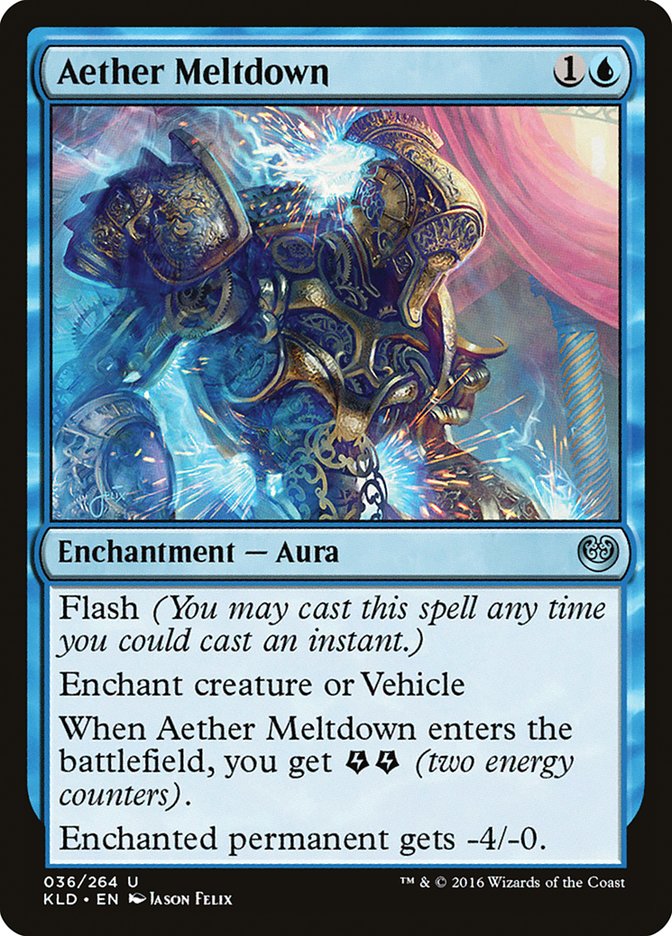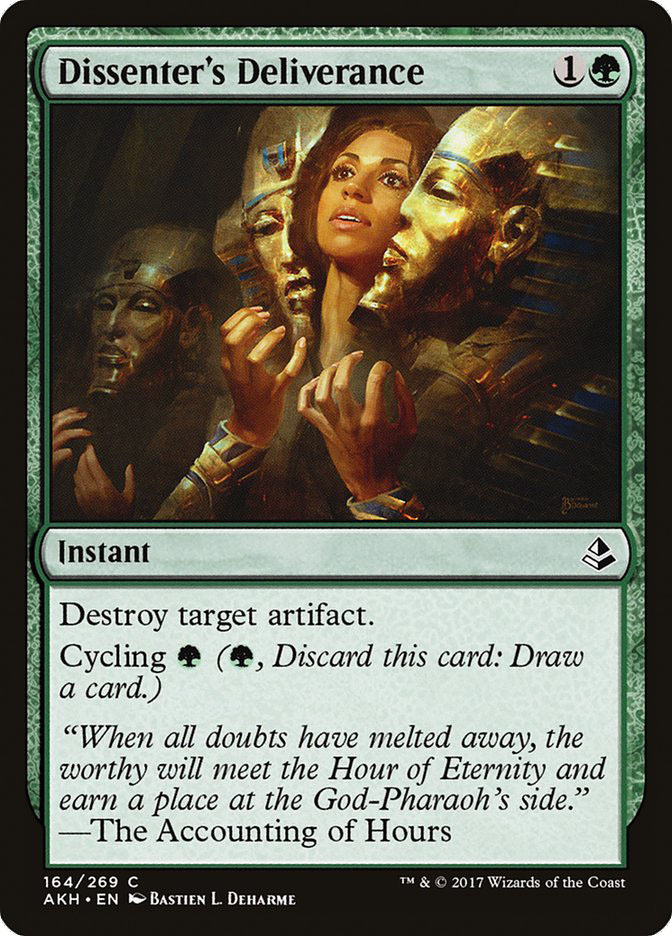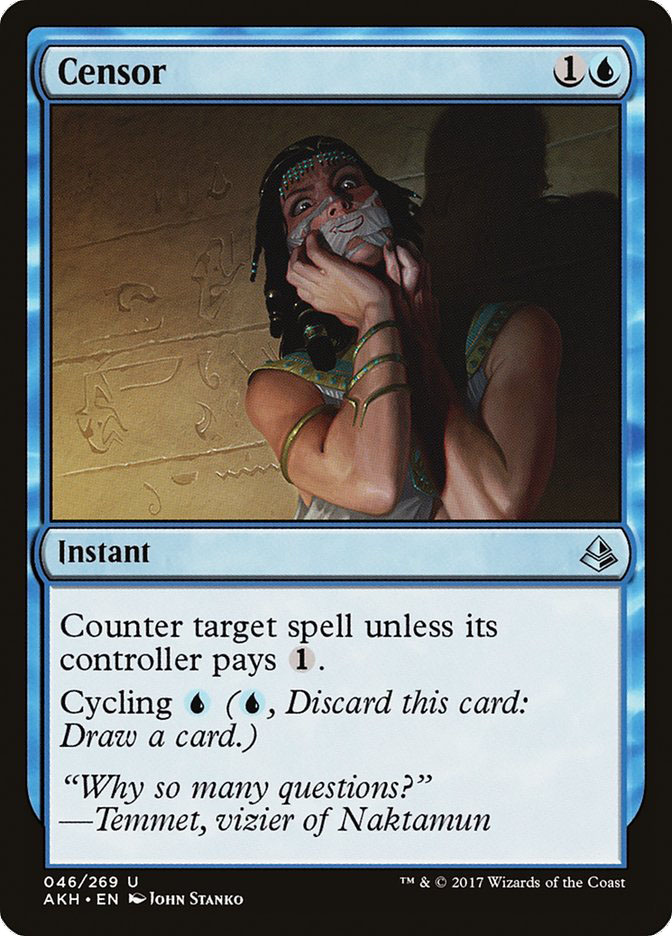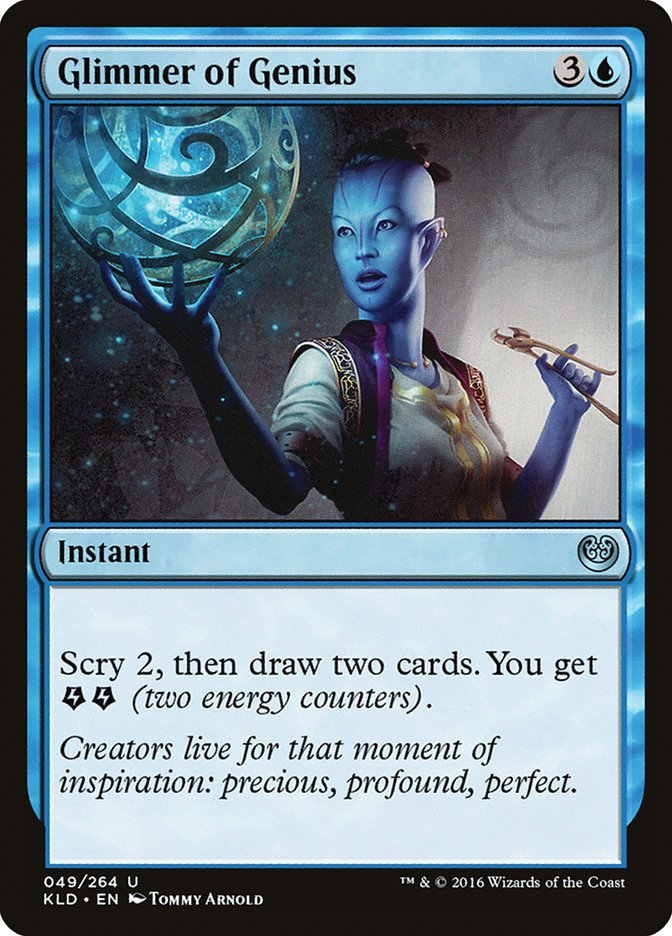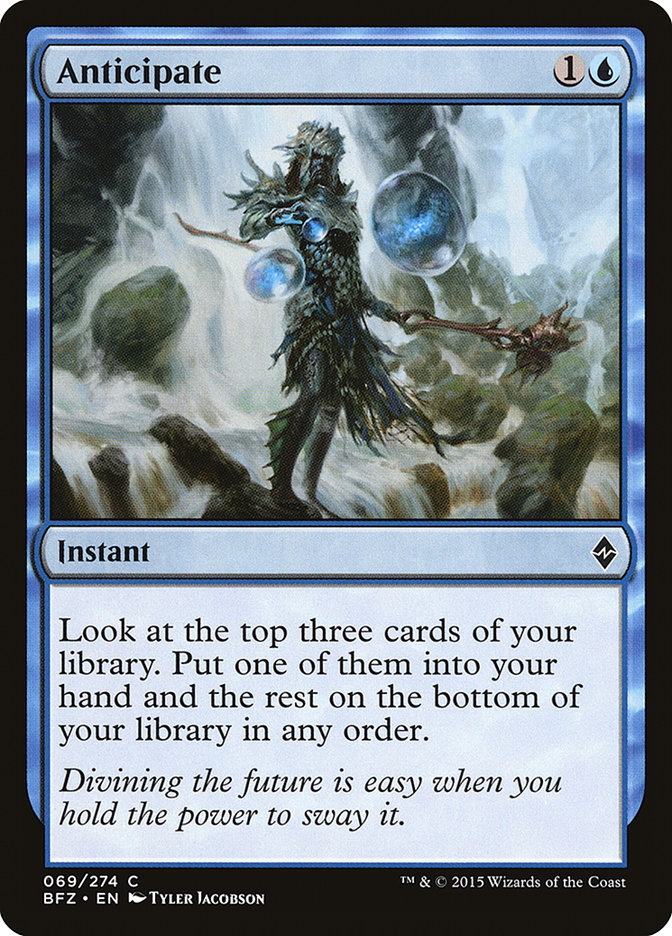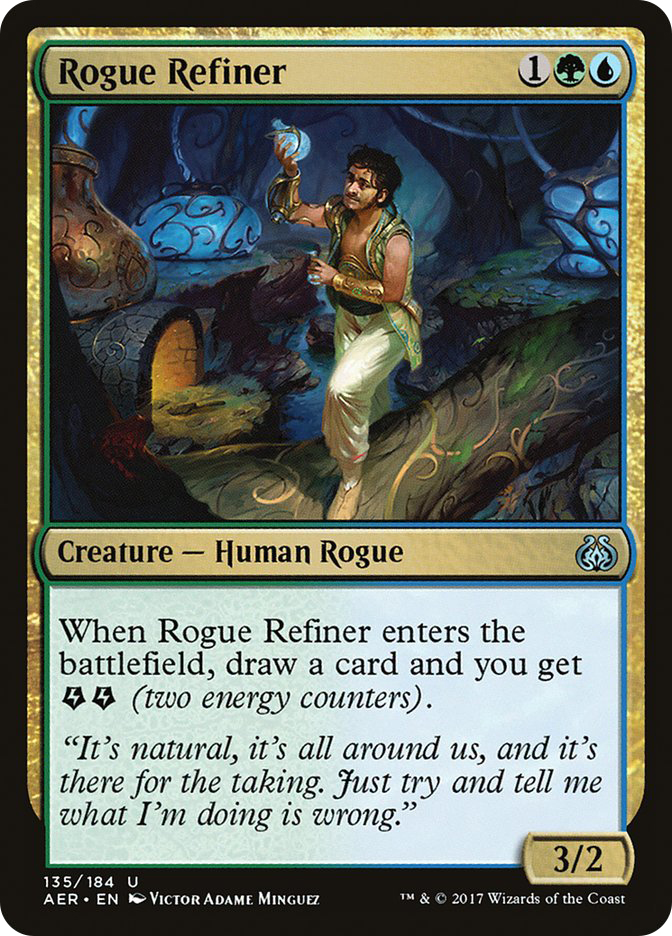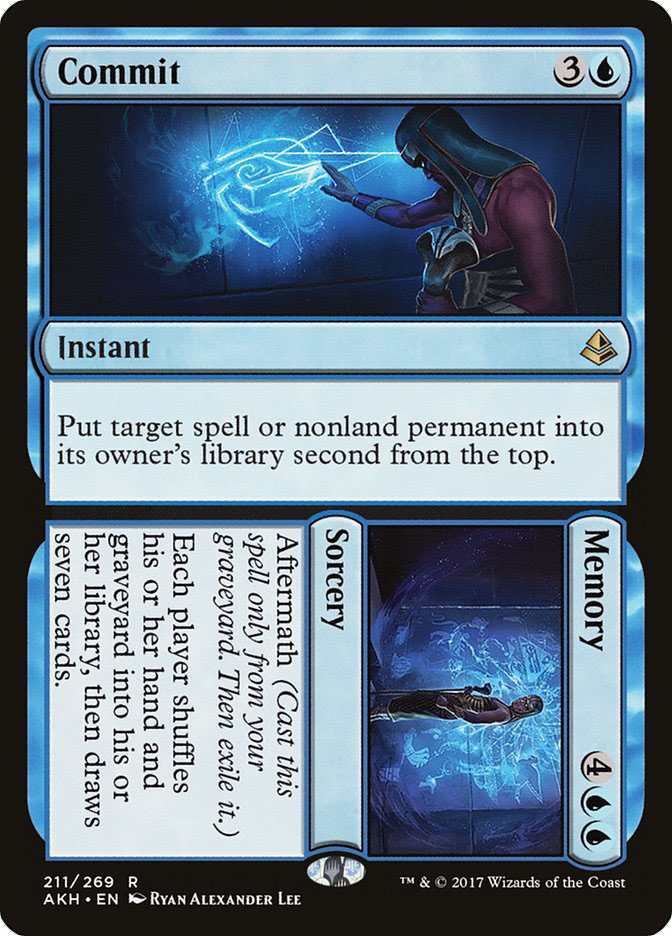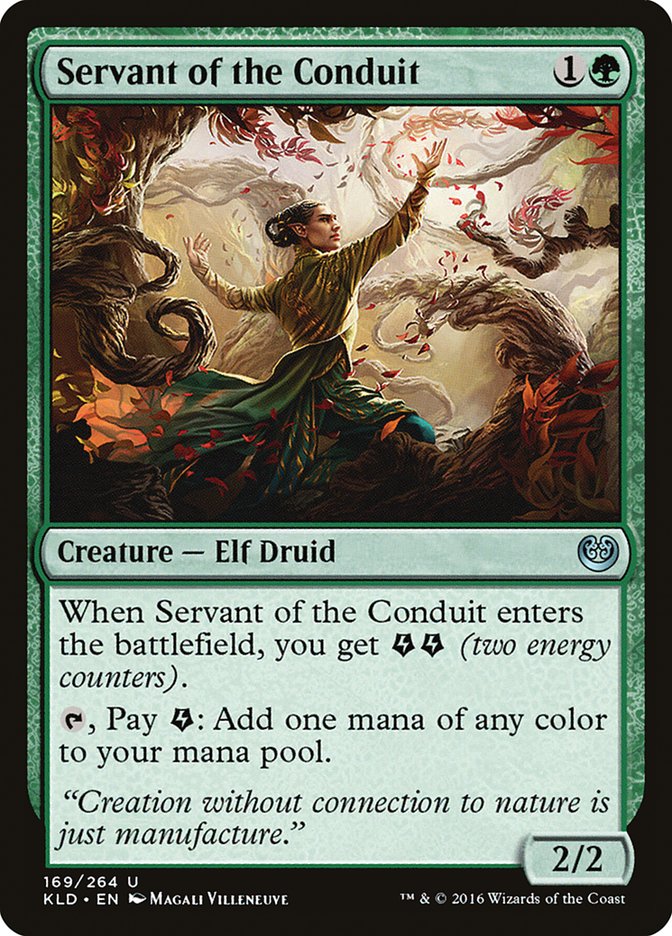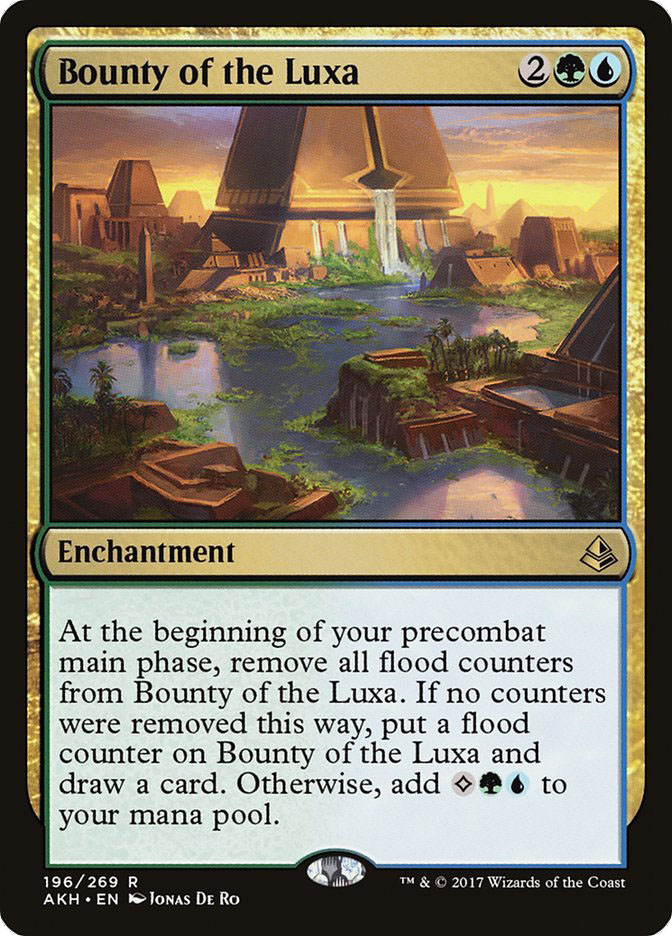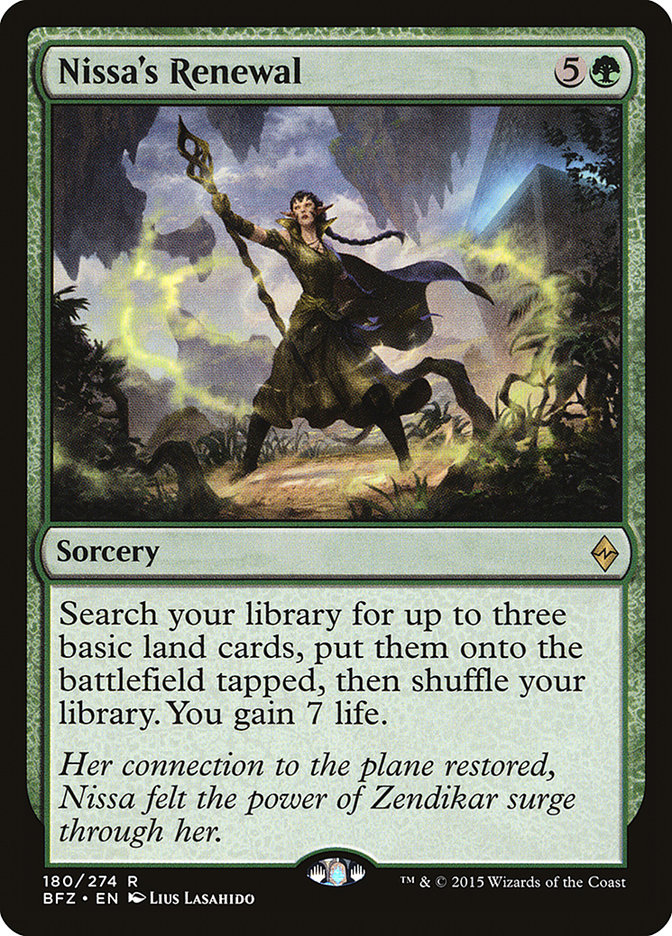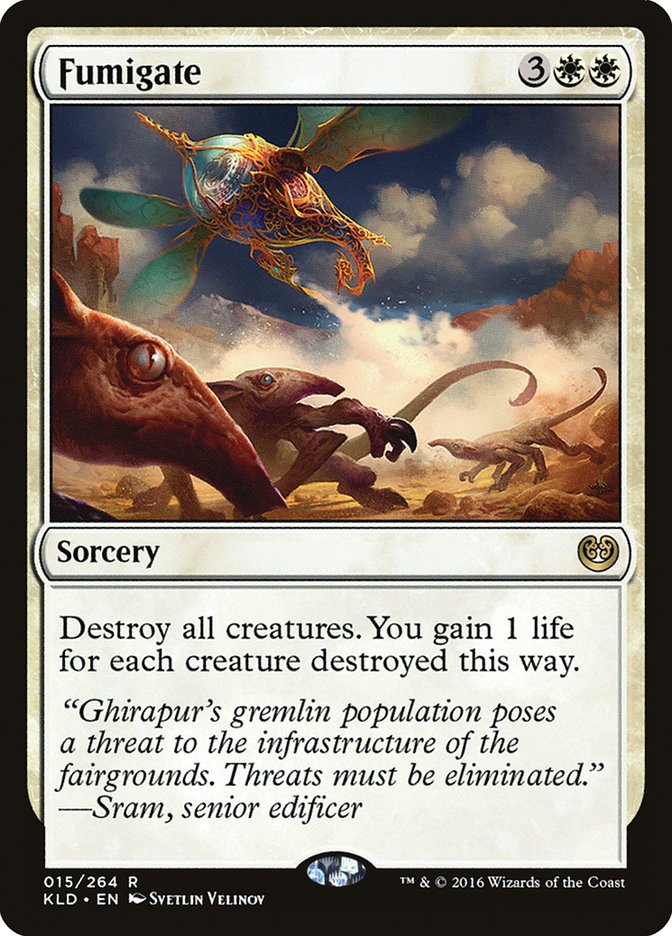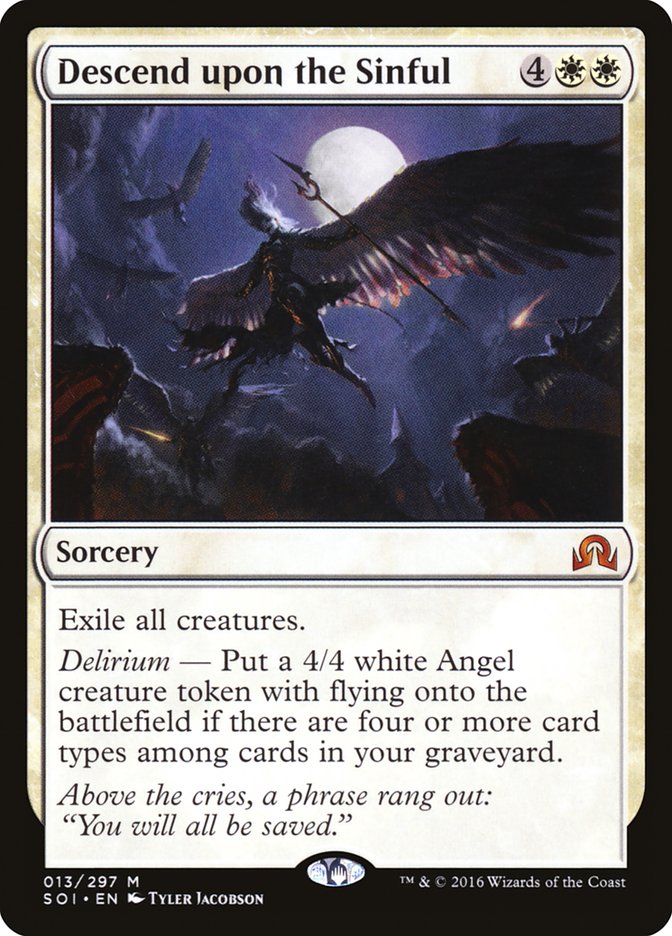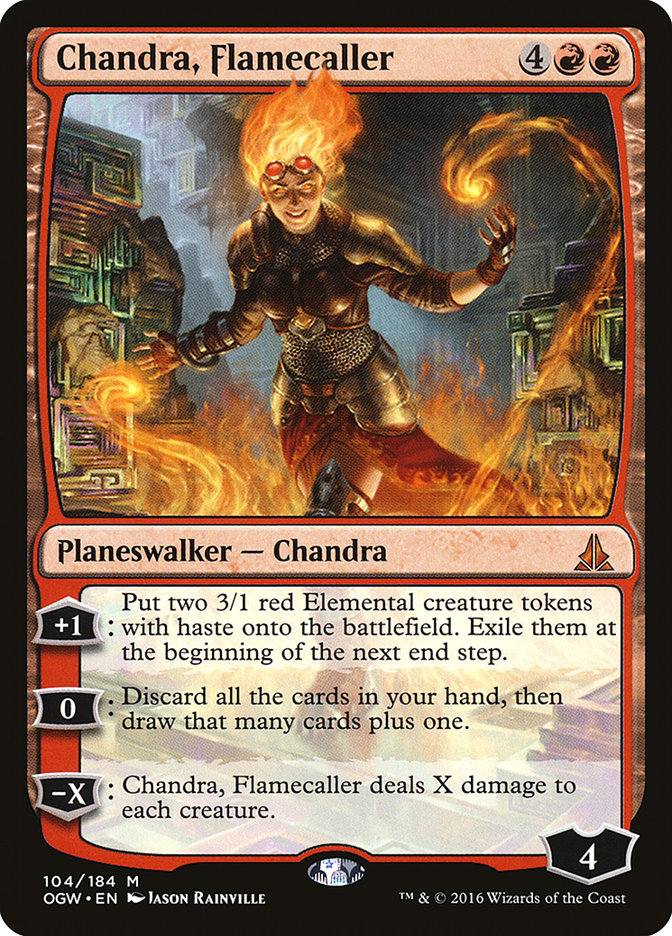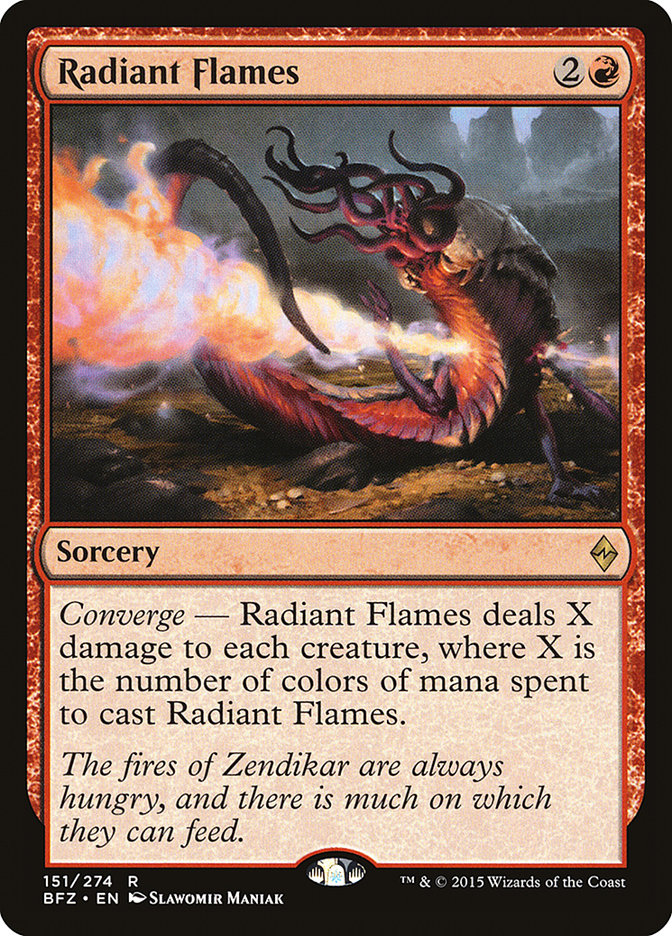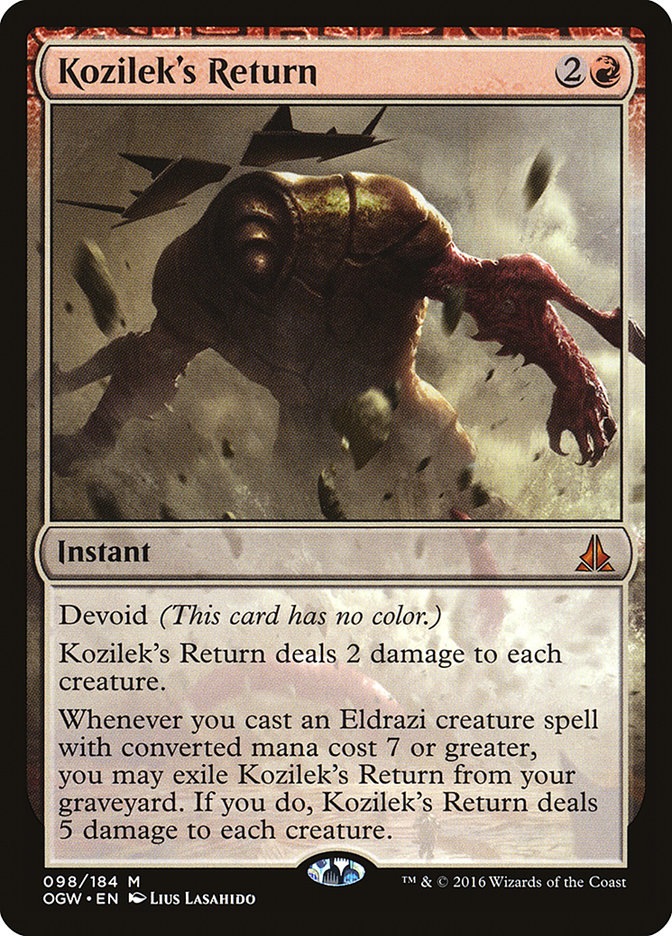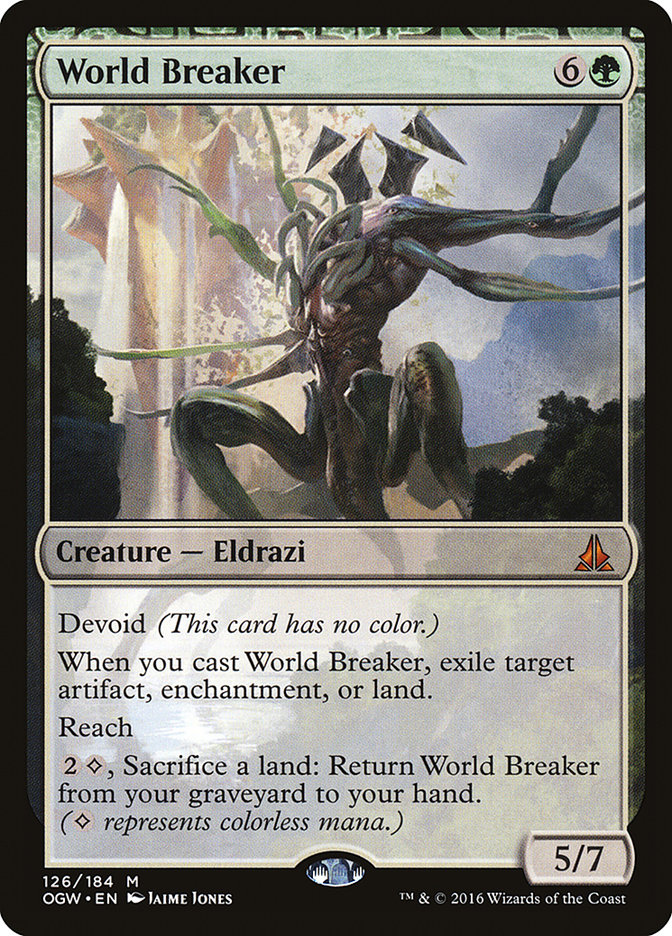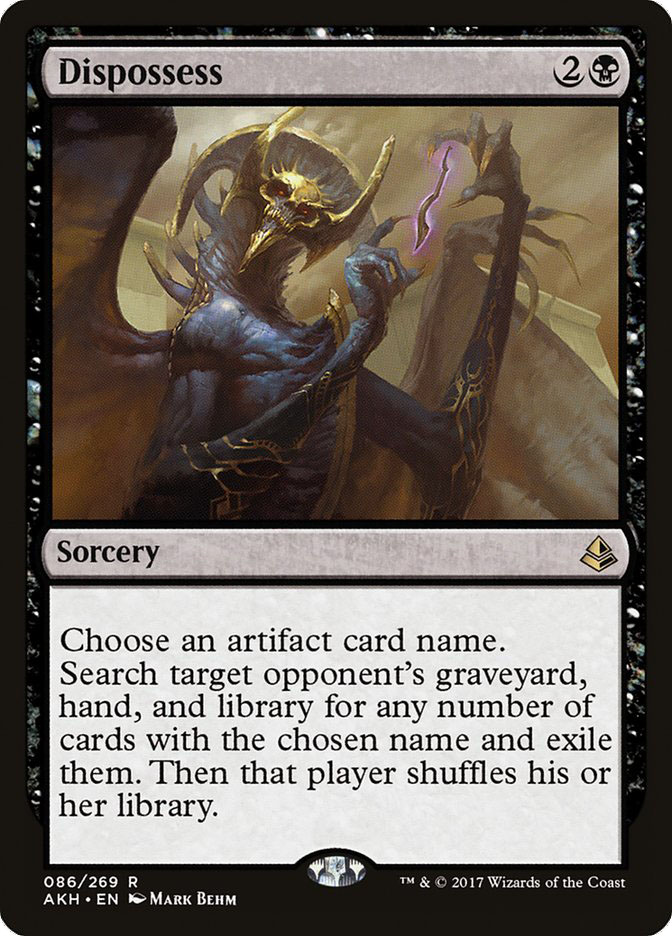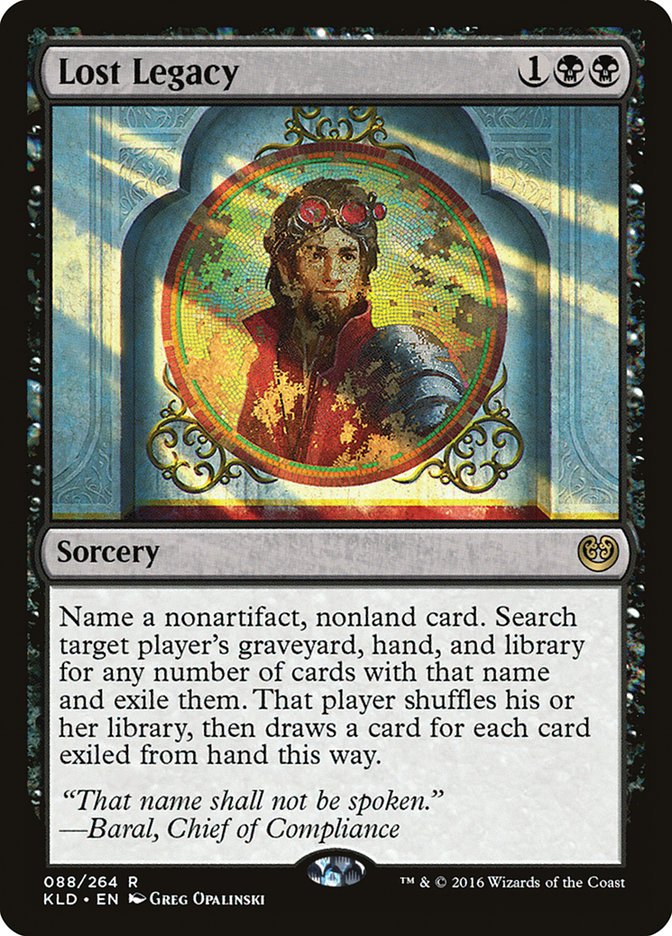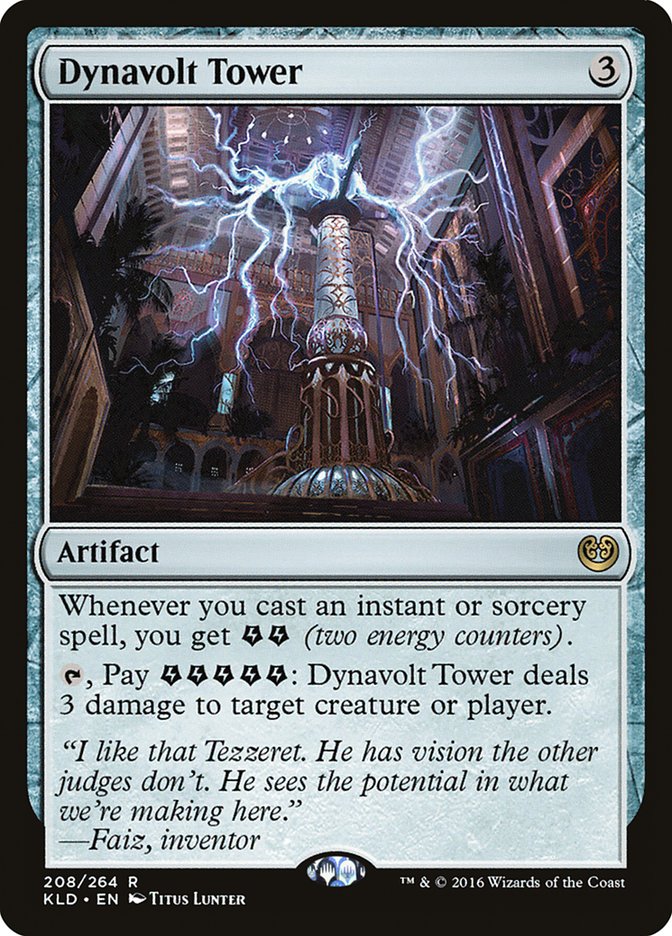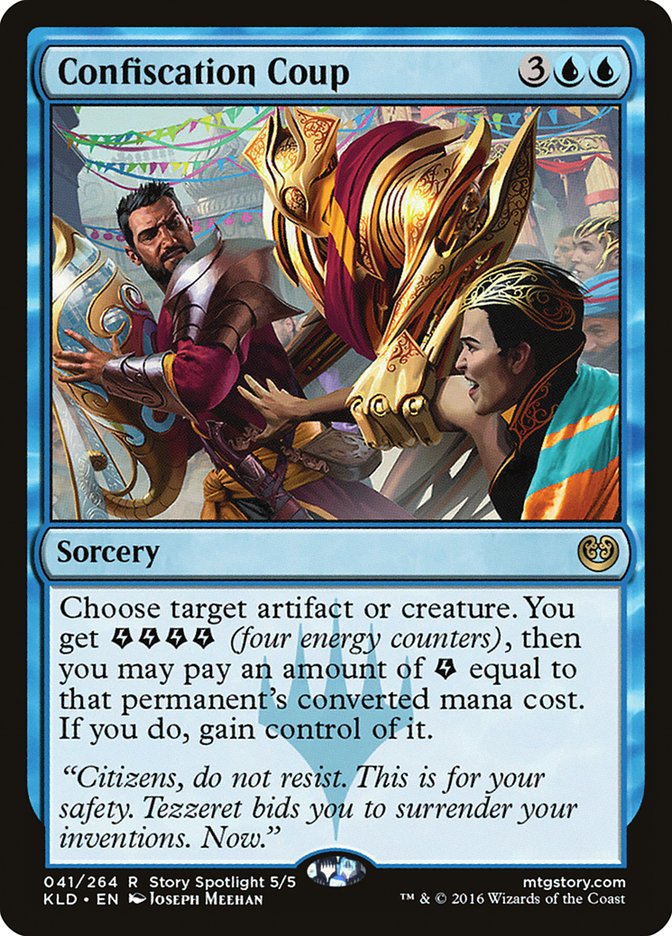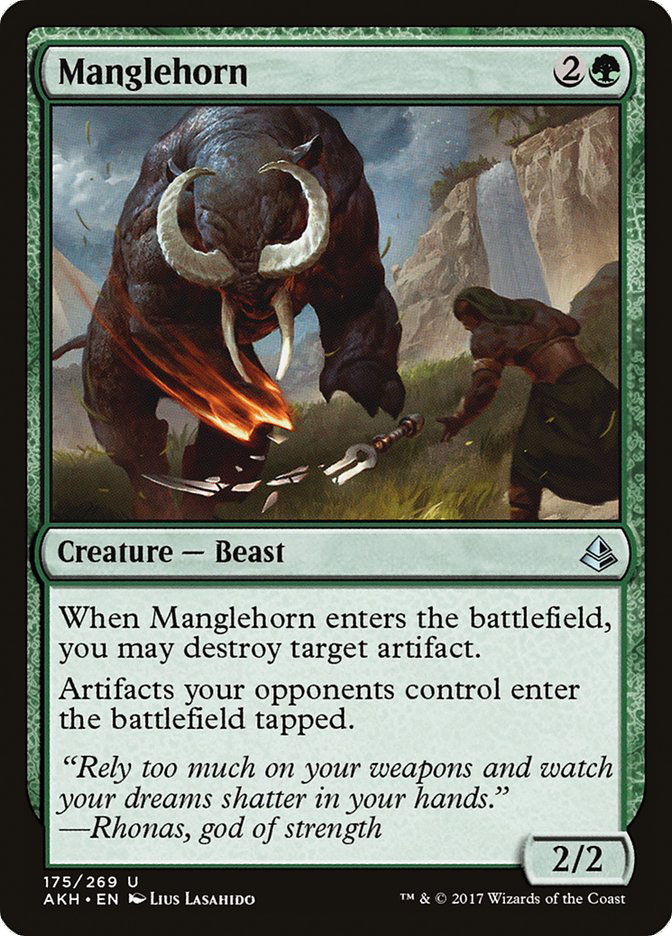Aetherworks Marvel put up a dominating performance at #PTAKH. Zombies may
have been the breakout deck, but Marvel really drove what happened at this
event.
Zombies is just a deck with creatures. It’s good but beatable.
Marvel is something else. It’s powerful, but as we learned in the Emrakul,
the Promised End era, it can be extremely flexible. For the near future you
have two options: play it or beat it.
For reference, here are the three current varieties.
First is what I consider to be the best creature heavy build in Martin
Mueller’s Top 8 list featuring Servant of the Conduit and Chandra,
Flamecaller. This is the list I would tell everyone to start testing
against.
Creatures (15)
Planeswalkers (4)
Lands (23)
Spells (18)
- 4 Aetherworks Marvel
- 4 Woodweaver's Puzzleknot
- 4 Harnessed Lightning
- 4 Attune with Aether
- 2 Aether Meltdown
Sideboard

Second is the halfway list with Glimmer of Genius played by Yuuya Watanabe.
It’s a bit less powerful in some ways, but a bit less likely to just be
stuck with crappy beatdown or five-card hands.
Creatures (10)
Lands (22)
Spells (28)
- 1 Negate
- 1 Kozilek's Return
- 4 Aetherworks Marvel
- 4 Woodweaver's Puzzleknot
- 4 Harnessed Lightning
- 4 Attune with Aether
- 4 Glimmer of Genius
- 3 Dissenter's Deliverance
- 3 Censor
Sideboard

Finally, there’s the pure control Bant or Four-Color list that part of my
team played. It has a bit more of a complete do nothing fail case, and as
is, ends up a bit behind in the mirror, but often crushes Mardu and
Zombies.
Creatures (4)
Lands (22)
Spells (34)
- 4 Anticipate
- 2 Nissa's Renewal
- 4 Aetherworks Marvel
- 4 Woodweaver's Puzzleknot
- 4 Harnessed Lightning
- 4 Attune with Aether
- 3 Fumigate
- 4 Aether Meltdown
- 4 Glimmer of Genius
- 1 Commit
Sideboard

Card by card, lets break down why these lists are built in divergent ways.
Aether Meltdown is not very good against a lot of the creatures in the
format. It doesn’t stop Winding Constrictor, Cryptbreaker, Diregraf
Colossus, or Tireless Tracker. The exception is when your opponent is
playing Heart of Kiran and Scrapheap Scrounger, at which point it becomes
quite good. Given that Mardu is not favored against Zombies and isn’t
default great against Marvel, I’m not sure how much that matters for the
coming weeks.
Worth noting: Even if you have Aether Meltdown in your Marvel deck, you
still need a plan for managing Gideon, Ally of Zendikar. Meltdown will not
save you there. I’ll get to how we managed that in Bant Marvel in a minute,
but the Temur Aetherworks plan is basically Thopter tokens and Ulamog
triggers. Not bad, but not comprehensive.
That said, I think Yuuya just broke it by playing tons of Dissenter’s
Deliverances in the same slot. Instead of a card that is only good versus
Heart of Kiran, this card is good versus Heart of Kiran, Aetherworks
Marvel, and drawing your bad cards at the wrong time. It’s likely this is
just right for the near future. It even kills Torrential Gearhulk, which is
a key in making your control matchups extend to the point where you have
ten lands and an Ulamog, the Ceaseless Hunger to resolve.
I’ve become less and less of a fan of Censor as a half cantrip in Marvel.
The extra interaction is nice, but the problem is the second copy of Censor
always sucks. Unlike control, your mana usage is really taxed by four mana
sorceries and three-drop creatures. Finding time to spend the blue to cycle
isn’t always easy. I don’t mind playing one or two to mise, but this is a
basic deck-building lesson. If you never want to draw two, then only play
one or two.
Moving to the real card draw, the real winner is Glimmer of Genius. That
card is phenomenal and a huge part of Marvel being able to effectively use
answers and sweepers to take control of a game. I would not play the deck
without at least three of that card. The fourth can lead to drawing the
second too early and is negotiable, but I would still bias towards having
it unless you are trying to find room for other similarly clunky cards like
Bounty of the Luxa.
Anticipate is merely fine. We played four as being able to find your
Fumigate or Aetherworks Marvel on time was super important, but if you are
playing creatures it isn’t necessary. Just having Thopter tokens buys you
approximately the same value in draw steps seen.
So why did we not like Rogue Refiner? Have you tried to block any of the
Standard creatures with it? They are all 4/4 fliers, have menace, cost
multiple mana less, or just recur. Rogue Refiner is good when it is
attacking control and midrange players, but we expected tons of Mardu and
Zombies where it’s really slow. It can be okay in the mirror, but honestly
that’s some small ball nonsense in the face of 10/10s. Your mediocre draws
are decided on that level, but the good ones end in other ways.
There is one thing that extra creatures do help with: exile-based removal.
In the face of a bunch of Cast Outs and counters it is possible to get run
out of Ulamogs. It almost happened to me in my round seven feature match.
If you have Rogue Refiners and Whirler Virtuosos, you could just lean on
the Ulamog three-for-one doing the job, but you have to go a bit deeper
without creatures. You need to time Aetherworks Marvel activations to
maximize the odds of a single Ulamog attack happening, but if that
fails…things get weird. You can Commit their removal spell or your Ulamog
in response to a kill spell, use the exile triggers to kill Cast Outs and
put copies of Ulamog back in your graveyard, putting as many lands and
Puzzleknots on the table as you can, and then cast Memory to try and Ulamog
your opponent off the lands necessary to kill the last one or two.
Be aware that against Declaration in Stone, legend rule protecting your
Ulamogs on the reshuffle involves casting one from hand then activating
Marvel hoping to hit the next one.
Yes, this falls fully into the nonsense realm.
In the core Aetherworks Marvel strategy, Servant of the Conduit is
basically a blank piece of cardboard. Yes, you can cast Aetherworks Marvel
on turn 3, but you absolutely can’t activate it then. A literal
Glassblower’s Puzzleknot might be better at enabling your combo, as at
least that one locks in another two energy the next turn.
When you are trying to protect Aetherworks Marvel from countermagic, the
bonus mana from Servant of the Conduit might help. The problem is that
spending a card to draw and cast Servant of the Conduit is probably worse
than drawing another card that actually requires a counter to answer. In
testing, our best Marvel decks against control could sideboard into no
Servants, no Woodweaver’s Puzzleknot, and just be stacked full of
threatening creatures, card draw, and counters.
The one place Servant of the Conduit is actively good is when you have some
non-Marvel permanent you are trying to cast. Chandra, Torch of Defiance and
Bounty of the Luxa are the two big winners on turn 3, and Chandra,
Flamecaller a turn early isn’t bad either. If you aren’t playing any of
these cards, you should stay away from adding four Grizzly Bears plus
energy to your deck.
Onto the bonus mana sources.
Chandra, Torch of Defiance is just bad. It does nothing the turn you cast
it and defending it is near-impossible. Everyone has too many creatures,
and your blockers aren’t good enough versus the quantity and quality that
Mardu and Zombies present. The quantity/cost of creatures being slanted
aggressively also means Chandra’s -3 ability is most likely leaving her
exposed to an attacker and dead. Maybe she would rock in a format with more
cards like Kalitas, Traitor of Ghet, but it turns out all of those kind of
creatures just suck against Ulamog. Sorry Chandra, maybe you will be great
once that nonsense and Archangel Avacyn rotate.
Bounty of the Luxa is not a card I tested a lot with, but it is super
interesting to me. A no-Marvel list actually did well early in the format
by leaning on this card. Having to wait two turns for mana is not ideal,
but the steady churn of cards and mana allows you to really go off with
other card draw effects, leading to you establishing battlefield control
without needing to resolve an Ulamog.
Nissa’s Renewal is a weird one.
It’s really good at casting Ulamog, but it’s also slow. It doesn’t do the
job without help, but if you are remotely close to stable before casting
it, there’s basically no chance things go bad with the bonus seven life.
That brings us to the sweepers.
Fumigate plus Nissa’s Renewal was the duo that drew us to Bant Aetherworks.
Fumigate is lights out for Zombies most games, and that pairing allows you
to win games without casting Aetherworks Marvel. Fumigate and Nissa’s
Renewal Time Walks the follow up with life gain, and suddenly a 10/10
exiles their stuff and the game ends. This is the sequence we used to
handle Gideon, Ally of Zendikar. You can do a good job of treading water
against five damage a turn with nine spells that gain life in your deck,
until some point where an Ulamog, the Ceaseless Hunger enters the stack and
Gideon is just gone.
Before you suggest Descend Upon the Sinful as a possible way to handle
Gideon, Ally of Zendikar, we thought about that. That would involve
clunking up your deck to support delirium and realizing your common play of
Ulamog into Wrath is now just a failure. If Archangel Avacyn and Selfless
Spirit get huge I could see it, but at the same time that probably means
you are playing against W/U Flash and should just play anything that isn’t
Aetherworks Marvel.
Chandra, Flamecaller is similarly good to Fumigate against Zombies, but
it’s also a huge threat against control and in weird mirror match scenarios
where everyone’s Marvels have died or decided to brick off. It’s also just
another good card to hit off Aetherworks Marvel, as the worst case scenario
is it cycles your remaining hand to find energy for the next spin of the
wheel. The only difference is you can’t fire it at instant speed off a
Marvel activation, which is an issue against Heart of Kiran. It is worth
noting you can still cast Chandra off an end of turn Marvel activation,
which is an important timing to play around Nahiri, the Harbinger’s -2
ability exiling a tapped Aetherworks Marvel.
Radiant Flames and Kozilek’s Return are there because sometimes the
expensive answers are just too slow. When Zombies curves out one through
five on the play you are just dead sometimes, or when they just have
multiple lords. Radiant Flames is distinctly better as a sideboard card as
it hits Lord of the Accursed, but Kozilek’s Return at instant speed is
better at holding off Scrapheap Scrounger. The Flashback really doesn’t
matter a ton, as usually if the front side was enough of a sweeper to
matter the Ulamog trigger is going to kill them regardless.
We had World Breaker in our sideboard. It sucked against most things.
It does wreck Heart of Kiran, but it’s a bit slow there. It was too clunky
for mirrors and one permanent just wasn’t enough. The one thing it did well
was beat people who thought Cast Out was an answer to Ulamog, the Ceaseless
Hunger. Bonus points if you play around the next Cast Out with Harnessed
Lightning on your own World Breaker.
On Disposess:
If you draw both of your Dispossess, that’s just not going to end well. The
Marvel deck has nothing worth spending the other one on, likely will have
shaved Woodweaver’s Puzzleknots in anticipation of playing the no-Marvel
game where energy is less relevant, and just exploit you being down a card
like a good control-ramp deck.
If you draw Lost Legacy and Dispossess, that’s just it. Game over, lights
out, etc. The first two Dispossess are good, but the third isn’t.
And if you are on the Dispossess side of this, you do want access to that
one and not just Lost Legacy. This week Ulamog, the Ceaseless Hunger was
the card that mattered, but next week you will need to fight Torrential
Gearhulk as well. Not that those decks can’t also win without their
flagship threat, but it’s much harder.
Torrential Gearhulk is pretty unexciting. A single 5/6 doesn’t really beat
or fight Zombies that well, it’s slow against Mardu, and is too small in
mirrors. Just give me a six-mana Chandra and call it a day.
Dynavolt Tower is a bit of a fixer upper for the creatureless lists. If you
ever play a matchup where Harnessed Lightning and Aether Meltdown aren’t
good, you are really short on energy production. Dynavolt Tower helps
bridge that gap. It also provides another way to handle the “more than just
power and toughness” creatures, like Winding Constrictor. The only problem
is that Dynavolt Tower is susceptible to people attacking you with
Manglehorn instead of Dispossess which punishes you for investing three
mana in the first place.
Tireless Tracker is overrated in mirror matches. Not bad, but overrated. It
was really good in the “do nothing but counterspell” mirrors early in the
format, but since then, people have started playing other threats and
leaving in Harnessed Lightning. Rogue Refiner and Whirler Virtuoso only
locked in the fact that spot removal is still good, which means Tracker
often just dies.
You can run away with a game because of Tireless Tracker, but you can also
just get stuck with a clunky sorcery speed spell that doesn’t interact or
add energy and have your primary plays fall apart as a result. If more
Ceremonious Rejections saw play, that might change as you can go full on
tempo, but for now bringing in a bunch of Dispels and Trackers is just an
easy way to die to turn 4 Marvel with energy.
The main reason Tireless Tracker is in your deck is that, in addition to
being fine but not broken in the mirror, it is one of the absolute best
cards against control. Dispel might be better there, but it isn’t dual use
in the same way Tireless Tracker is, as it is too narrow in mirrors in
large numbers. You do still have a few very distinct archetypes to cover,
so getting that extra value on each sideboard slot does matter a ton.
The card I wish we had was Confiscation Coup. While it doesn’t quite cover
the energy deficiency against control, it is absurdly powerful in the
mirror matchup. It upsets Tireless Tracker (if that matters in a game) and
breaks games where Aetherworks Marvel misses. I never actually saw it cast,
but just thinking about the blowouts it can easily induce is crazy.
Manglehorn is the other beating to deliver in a mirror match. The dream is
picking off a Woodweaver’s Puzzleknot and using the Root Maze ability to
hold off a second Marvel just long enough to Dissenter’s Deliverance it.
Having a Manglehorn also means that even if your opponent resolves their
Marvel, you get to use their tap down to resolve yours and fire away first.
This is another vote against Torrential Gearhulk and basically any other
artifact: dying to Manglehorn without the chance of producing an Ulamog
first sucks.
Marvelous!
These are only the options from these early weeks’ iterations of the deck.
As other new decks come in and out of the metagame, new choices will
surface and Temur variants will cycle through all sorts of options. This
also doesn’t even cover the Sultai Delirum spectrum, which can only get
better with more time and tuning.
Like it or not, Aetherworks Marvel is here to stay as a fixture of the
Standard format. You need to adjust to it; and if you play the deck, you
have to understand you have the tools to adjust to everyone else. You are a
broken deck, but you have the tools script a fair game however it best
suits you. Find them and use them.


